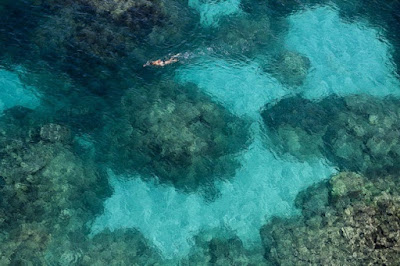 |
| © Swimmer off Blue Bay, Island of Mauritius, Republic of Mauritius Yann Arthus-Bertrand |
The main critic of cost-benefit analysis (CBA); the traditional economical formula to measure economical wealth, applied to the environmental and social issues, is limited. It is impossible to measure in dollar amount biodiversity or people's lives.
Human evaluation, in a monetary sense, must reflect the best value in terms of aesthetic and spiritual assets since its not because something or someone has no market value that we should let them die. An example is the case of the sick child, the market logic won’t be applicable in looking for his treatment however, we must save the child. For natural resources such as access to water, pure air and soil, it means for the people with no access to them; death, people do not die of lack of incomes but they die for not accessing vital natural resources.
Another monetary evaluation; the method of contingent variation (CV), used when pricing a specie or the aesthetic value of ecosystems does not understand that maintaining biological diversity includes improving the health of all ecosystems and that even the most unpopular insects is part of it. The perfect demonstration is the value of pest. For example pest, who wants to save pest? yet, if we exterminate insects, for example, the suppression of 68 herbivore species are link to the distortion of some insects and parasitoids. An ecosystem is a circle of life and eliminating one of its species is jeopardizing the entire ecosystem.
Assessing the economic value of ecosystem services by using dollars does not require that it be bought and sold on global market places, thus, dollar figures can be used as an indicator that has a concrete representation for people. It is easier to mobilize media, people and politics with figures such as; in 1997, the value of the global ecosystem was estimated at $33 trillion, compare with the 2009 world’s GDP was $58,141 trillion. However, placing value on ecological services and natural resources can be good for alerting and saving in the emergency in where we are now.
Assessing the economic value of ecosystem services by using dollars does not require that it be bought and sold on global market places, thus, dollar figures can be used as an indicator that has a concrete representation for people. It is easier to mobilize media, people and politics with figures such as; in 1997, the value of the global ecosystem was estimated at $33 trillion, compare with the 2009 world’s GDP was $58,141 trillion. However, placing value on ecological services and natural resources can be good for alerting and saving in the emergency in where we are now.
Another approach, to value nature is the “travel cost method”, to measure recreational attribute of National Parks for example. The method can reflect actual choice by consumers and might help pricing, assessing and saving natural resources used by humans for recreational benefits. Furthermore, biodiversity is disappearing at an unprecedented rate. The U.S. Fish and Wildlife estimates that more than 500 U.S species have gone extinct during the past 200 years, thus, the discussion on the dollar value placed on the global ecosystems and environmental services can and must be debated until an alternative solution could emerged and save the environment from an economically predicted destruction. The value of ecological services and their importance in policy making decision must be a global and urgent preoccupation and until global awareness on the vital threat of destructing the environment is becoming our number one preoccupation.
We all agree that nature must not be seen as a free good any longer, as an example is the fast depletion of the world fish stock. It is not possible to pollute the own source of our subsistence any longer. Another example, our drinking water, which is a limited vital supply where we dump our pesticides and wastes. The cost of pollution is real and can be estimate in dollar value “but it has been individuals and governments to bear the costs associated with those effects ”. These costs must be measured in a monetary sense and being included in the cost-benefit analysis. In economical terms these externalities must be internalized because before having a debate about valuating nature with a classic economical approach, this economical method must be accurate and must take into account the real cost of our pollution.
We all agree that nature must not be seen as a free good any longer, as an example is the fast depletion of the world fish stock. It is not possible to pollute the own source of our subsistence any longer. Another example, our drinking water, which is a limited vital supply where we dump our pesticides and wastes. The cost of pollution is real and can be estimate in dollar value “but it has been individuals and governments to bear the costs associated with those effects ”. These costs must be measured in a monetary sense and being included in the cost-benefit analysis. In economical terms these externalities must be internalized because before having a debate about valuating nature with a classic economical approach, this economical method must be accurate and must take into account the real cost of our pollution.
The real paradox of the debate is that if more ecological consideration and sustainable scientific solutions can be applied to industries and economical activities, the stage of the biodiversity and important natural resources would in a better shape and our economical situation as well.
References:
Taking Sides: Taking Sides: Clashing Views on Environmental Issues, 13th Ed.
Publisher: McGraw-Hill. Paperback
World Bank. World Development Indicators. http://data.worldbank.org/data-catalog/world-development-indicators?cid=GPD_WDI
Berg, L.R., & Hager, M.C. (2009). Visualizing environmental science (2nd Ed.). Hoboken, NJ: John Wiley & Sons, Inc.
Publisher: McGraw-Hill. Paperback
World Bank. World Development Indicators. http://data.worldbank.org/data-catalog/world-development-indicators?cid=GPD_WDI
Berg, L.R., & Hager, M.C. (2009). Visualizing environmental science (2nd Ed.). Hoboken, NJ: John Wiley & Sons, Inc.

No comments:
Post a Comment